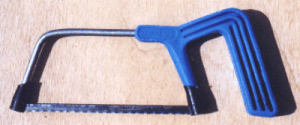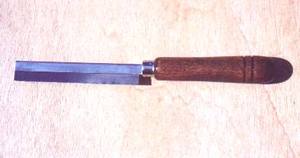 |
The junior hacksaw is a tool designed for cutting metal. . .but fortunately it is capable of cutting almost everything else, including, of course, wood. (If we needed to work with thicker pieces of wood though, we would find the junior hacksaw very unsatisfactory).. The BLUE handled saw shown opposite is a basic junior hacksaw - cheap to buy and easy to use. The blade can be replaced when blunt although a blade will last a very long time if it's only used for cutting softwood. Changing the blade is difficult - you need to press the saw 'end-to-end' to bend the frame and so release the blade. Don't attempt it on a smooth surface! |
The vast majority of cutting tools cut when they are PUSHED. Saws, files, planes, chisels, most are designed to cut away from the body. Why do you think? Just a few work when pulled - a modelling knife, for example. The tiny teeth on the hacksaw blade are shaped so that they point forward like most saws, but some saws whose design comes from other countries are PULL saws and the little modelling saw shown on the left is one of these.
|
|
 |
The saw with the frame consisting of a bent steel bar is the original design for a junior hacksaw. Such saws are still made and sold and they use exactly the same blade as the others. The handle is uncomfortable to hold and the shape makes the saw difficult to control. (Used in hospital operating theatres because they're easier to clean!) | ||
| The YELLOW saw has a lever fitted below the handle which tensions the frame. This allows the blade to be removed very easily, although it makes them more expensive. If you replace a blade you have to be careful to fit it the right way round. Look at the section of text on the right. | |||
 |
Most saws have permanent blades and some have a strip of metal along the top of the blade to keep the blade straight. These are called back saws. The one shown bottom left is called a modelling saw and has a blade only 1cm wide, so it cannot cut deeper than 1cm. Interestingly the kind shown here have the blade fitted the 'wrong' way round! Read the text on the right for an explanation.
|